

David Tong: Quantum Field Theory. These lecture notes are based on an introductory course on quantum field theory, aimed at Part III (i.e. masters level) students.
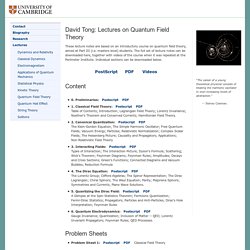
The full set of lecture notes can be downloaded here, together with videos of the course when it was repeated at the Perimeter Institute. Individual sections can be downloaded below. PostScript PDF Videos 0. Preliminaries: Postscript PDF 1. Philip Tanedo, who took this course long ago, has put together a useful literature review of quantum field theory textbooks. Grand Orbital Table by Manthey. Grand Orbital Table All atomic orbitals with n<=10 are presented here.
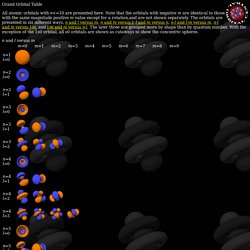
Note that the orbitals with negative m are identical to those with the same magnitude positive m value except for a rotation,and are not shown separately. The orbitals are presented in six different ways, n and l versus m, n and m versus l, l and m versus n, n-l and l-m versus m, n-l and m versus l-m, and l-m and m versus n-l. A Lazy Layman's Guide to Quantum Physics. That's an easy one: it's the science of things so small that the quantum nature of reality has an effect.
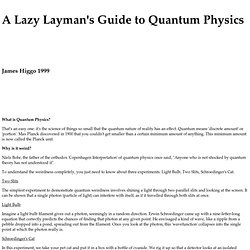
Quantum means 'discrete amount' or 'portion'. Max Planck discovered in 1900 that you couldn't get smaller than a certain minimum amount of anything. This minimum amount is now called the Planck unit. The meaning of quantum physics is a bit of a taboo subject, but everyone thinks about it. To make it all a bit more respectable, it is better to say 'ontology' than 'meaning' -- it's the same thing. The Strong Force for Beginners. “I found I could say things with color and shapes that I couldn’t say any other way — things I had no words for.”

–Georgia O’Keeffe When it comes to the Universe, it isn’t just the stuff that’s in it that’s important. Image credit: 2MASS Extended Source Catalog (XSC). It’s also how all that stuff interacts with itself and everything else. To the best of our knowledge, there are four fundamental forces in the Universe, and they’re all essential to our existence.
Image credit: Stichting Maharishi University of Management, the Netherlands. Some of them are familiar, like gravitation. Image credit: Mark Garlick / SPL. Quantum Diaries. We’ve been discussing the Higgs (its interactions, its role in particle mass, and its vacuum expectation value) as part of our ongoing series on understanding the Standard Model with Feynman diagrams.
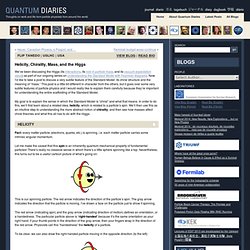
Now I’d like to take a post to discuss a very subtle feature of the Standard Model: its chiral structure and the meaning of “mass.” This post is a little bit different in character from the others, but it goes over some very subtle features of particle physics and I would really like to explain them carefully because they’re important for understanding the entire scaffolding of the Standard Model. My goal is to explain the sense in which the Standard Model is “chiral” and what that means. In order to do this, we’ll first learn about a related idea, helicity, which is related to a particle’s spin.
The Second Superstring Revolution. And the Winner is... Many-Worlds! This is one of several shortened indices into the Quantum Physics Sequence.
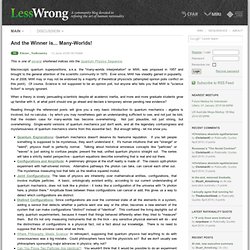
Macroscopic quantum superpositions, a.k.a. the "many-worlds interpretation" or MWI, was proposed in 1957 and brought to the general attention of the scientific community in 1970. Ever since, MWI has steadily gained in popularity. As of 2008, MWI may or may not be endorsed by a majority of theoretical physicists (attempted opinion polls conflict on this point). Of course, Science is not supposed to be an opinion poll, but anyone who tells you that MWI is "science fiction" is simply ignorant. When a theory is slowly persuading scientists despite all academic inertia, and more and more graduate students grow up familiar with it, at what point should one go ahead and declare a temporary winner pending new evidence?
Quantum Explanations: Quantum mechanics doesn't deserve its fearsome reputation. Free physics Animations- Learnerstv. Lectures. Introduction to quantum mechanics. Many aspects of quantum mechanics are counterintuitive[3] and can seem paradoxical, because they describe behavior quite different from that seen at larger length scales.
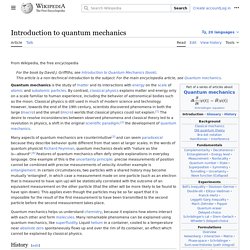
Personal and Historical Perspectives of Hans Bethe. Physics for the 21st Century. Course Overview Welcome to Physics for the 21st Century: an on-line course that explores the frontiers of physics.
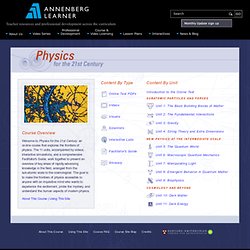
The 11 units, accompanied by videos, interactive simulations, and a comprehensive Facilitator's Guide, work together to present an overview of key areas of rapidly-advancing knowledge in the field, arranged from the sub-atomic scale to the cosmological. HPS 0410 Einstein for Everyone. Title page, Preface and Table of Contents for Einstein for Everyone Introduction: the Questions Special Relativity Special Relativity: the Principles Special Relativity: Clocks and Rods Special Relativity: Adding Velocities.
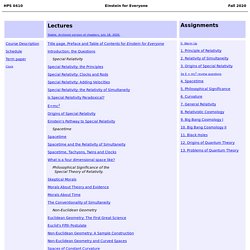
Physics Documents. The Everett Interpretation. This FAQ shows how quantum paradoxes are resolved by the "many-worlds" interpretation or metatheory of quantum mechanics.

This FAQ does not seek to that the many-worlds interpretation is the "correct" quantum metatheory, merely to correct some of the common errors and misinformation on the subject floating around. As a physics undergraduate I was struck by the misconceptions of my tutors about many-worlds, despite that it seemed to resolve all the paradoxes of quantum theory . The objections raised to many-worlds were either patently misguided or beyond my ability to assess at the time , which made me suspect (confirmed during my graduate QFT studies) that the more sophisticated rebuttals were also invalid.
I hope this FAQ will save other investigators from being lead astray by authoritative statements from mentors. The Transactional Interpretation of Quantum Mechanics. John G. Cramer This paper was originally published in Reviews of Modern Physics 58, 647-688, July (1986). It is copyrighted (©1986) by John G. Quantum mysteries. John Gribbin For seventy years, physicists have worried about what quantum mechanics means. They can use quantum physics, to be sure; witness the successful designs of lasers and computer microchips, and the understanding of molecules that makes genetic engineering possible.
Quantum Mechanics Explained.